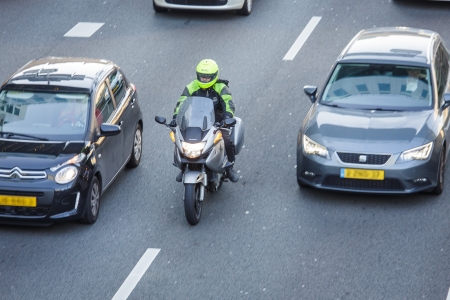Measures to increase the safety of motorcyclists are especially considered in the technical/intelligent vehicle developments (see examples below). Often inspiration is sought in vehicle developments for cars. Adapting ITS systems for cars to motorcycles, however, is difficult [43] [44]. An intelligent system must for instance ‘accept’ that a motorcycle in a bend has a smaller angle than a car.
Digital conspicuity
Digital conspicuity means that vehicles can communicate with each other in traffic, so that car drivers are warned about the presence of a motorcyclist on the road. SAFERIDER [45] attempts to integrate different intelligent warning systems already used for cars (Speed Alert, Curve Speed Warning, Frontal Collision Warning and Intersection Support) on motorcycles. This means that they will be adapted for motorcycles in such a way that the systems work correctly and do not obstruct the motorcyclist while riding. The project is promising, but as long as not (almost) all vehicles on the road have such a communication system, the effect on road safety is limited.
The crash risk of motorcyclists without a communication system might even increase, if car drivers rely too much on their warning system and therefore fail to detect motorcycles [46].
E-Call
The e-Call system records serious crashes, automatically dials the emergency number and reports location, time and direction of travel of the casualty, after which the emergency room will attempt to contact the driver. The European Commission has proposed to make e-Call mandatory in all new cars in 2018. The European Two-Wheeler Retailers' Association ETRA [47] has examined whether this system could be effective on motorcycles. They concluded:
- Powered two-wheelers have more complex dynamic movements, which makes automatic registration of a serious crash different (and usually more difficult) than for cars.
- In a crash the rider of a powered two-wheeler will more easily be separated from the vehicle, which makes a system on the vehicle less effective than a system on the driver (e.g. in helmet or clothing). This is important for:
- the determination of the exact location of the casualty;
- the necessary communication between casualty and the rescue workers who are on their way to the crash location.
Airbags
Several researchers have investigated the possibilities of airbags on the motorcycle [48] [49] [50]. However, a motorcyclist is positioned differently on a motorbike than a driver is positioned in a car; moreover, the forces on a motorcycle are different. It is therefore difficult to determine the shape of the air bag (so that it does not injure the rider) and to determine the moment at which the air bag must be activated.
